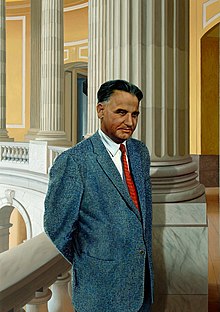Dalip Singh Saund
This article needs additional citations for verification. (January 2013) |
Dalip Singh Saund | |
|---|---|
 Painting on canvas of Saund | |
| Member of the U.S. House of Representatives from California's 29th Congressional district | |
| In office January 3, 1957 – January 3, 1963 | |
| Preceded by | John J. Phillips |
| Succeeded by | George Brown, Jr. |
| Personal details | |
| Born | September 20, 1899 Chhajulwadi, Punjab, India |
| Died | April 22, 1973 (aged 73) Hollywood, California |
| Nationality | American |
| Political party | Democratic |
| Spouse | Marian Saund |
| Children | Dalip Singh Saund Jr., Julie Saund, Ellie Saund |
| Alma mater | University of California, Berkeley |
Dalip Singh Saund (Punjabi: ਦਲੀਪ ਸਿੰਘ ਸੌਂਦ) (September 20, 1899 – April 22, 1973) was an American politician who was a member of the United States House of Representatives. He served the 29th District of California from January 3, 1957 to January 3, 1963. He was the first Sikh American/Asian American/Indian American elected as a voting member of the United States Congress.
Biography
Born in Chhajulwadi, Punjab, India, to a Sikh family, he received his bachelor's degree in mathematics from the University of Punjab in 1919.
He immigrated to the United States (via Ellis Island) originally to study agriculture at the University of California, Berkeley. While at the university, he obtained a master's degree (1922) and a PhD (1924), both in mathematics. He thereafter remained in the United States, becoming a successful farmer.
Later, he campaigned to allow "Hindus", as all people of South Asian descent were called at that time, to become naturalized citizens. After the Luce-Celler Act was passed in 1946, he applied for naturalization and became an American citizen in 1949. He ran for election in 1950 as a Justice of the Peace for Westmoreland township, California, and won the election, but his election was thrown out as he had been a citizen for less than a year. He later ran again for the same post and won.[1]
In November 1955, he announced his campaign to run for the House of Representatives as a Democrat and won an election for an open seat against a famous Republican aviator, Jacqueline Cochran. He was re-elected twice, becoming the first Sikh American, the first Asian American, the first Indian American and first member of a non-Abrahamic faith to be elected to Congress.[2]
In May 1962, Saund suffered a severe stroke which left him unable to speak or walk without assistance. He was defeated for reelection by Republican Patrick Martin by a 56% to 44% margin.
Publications authored
- My Mother India. Stockton, California: Pacific coast Khalsa Diwan society (Sikh temple). c. 1930. p. 218. LCCN 30013748. OCLC 3401226. LCC DS421 .S25 OCLC 253315388
- This book was written as a critique to the sensational Mother India, by Katherine Mayo, which argued against Indian self-rule.[3]
- Congressman From India. New York: Dutton. 1960. p. 192. LCCN 60012293. OCLC 1098264. LCC E748.S28 A3
- Gandhi, the man and his message. n.p. n.d. p. 14. OCLC 20750572.
See also
References and notes
- ^ "Dalip Singh Saund among Asian American trailblazers: Obama". The Times Of India. May 9, 2012.
- ^ He is to date the only member with Sikh heritage to have served in Congress, though Congressman Martin Hoke (R-OH) lived as a Sikh for a period of time in the 1970s.
- ^ Tisdale, Sara (December 19, 2008). "Breaking Barriers: Congressman Dalip Singh Saund". Pew Forum on Religion & Public Life. Pew Research Center. Retrieved March 10, 2012.
- United States Congress. "Dalip Singh Saund (id: S000075)". Biographical Directory of the United States Congress.
- "Triumph and Tragedy of Dalip Saund" by Tom Patterson, California Historian, June 1992 (PDF)
- PBS special "Roots in the Sand"
External links
- 1899 births
- 1973 deaths
- American politicians of Indian descent
- American Sikhs
- California Democrats
- Indian-American history
- Indian emigrants to the United States
- Members of the United States Congress of Asian descent
- Members of the United States House of Representatives from California
- Punjabi people
- University of California, Berkeley alumni
- University of the Punjab alumni
- Burials at Forest Lawn Memorial Park (Glendale)
- American people of Punjabi descent
- Democratic Party members of the United States House of Representatives
- 20th-century American politicians
